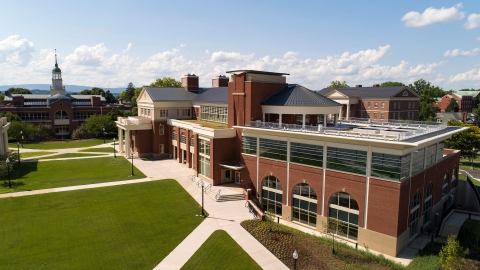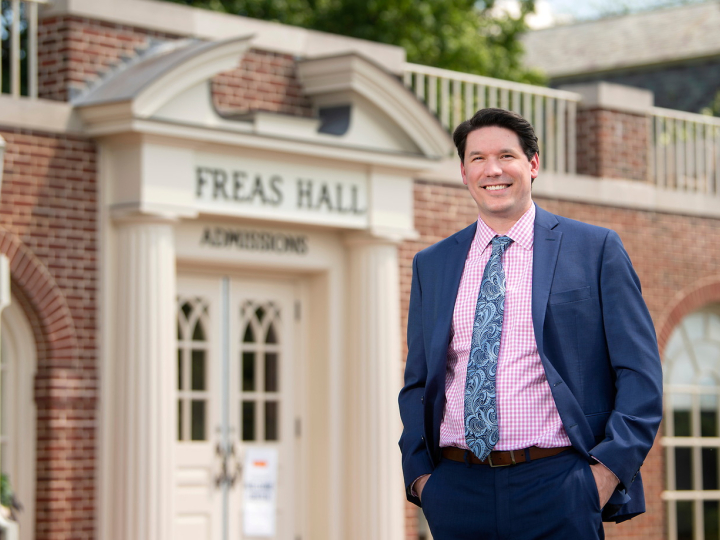
Bucknell Opens Academic East, a Student-centered Hub for Innovation and Exploration
August 29, 2019
The 78,000-square-foot academic building nearly doubles the lab space available to students in the College of Engineering, and offers innovative teaching and research spaces for the Department of Education.
Dan Cavanagh, chair of Bucknell University's Department of Biomedical Engineering, has a piece of advice for high school students touring college campuses. When they show you their labs, and their state-of-the-art equipment, make sure to ask, "When do I get to use that?"
Academic East, which opened for classes this week at Bucknell, is a center for high-tech innovation with 25 labs housing cutting-edge research equipment found almost nowhere else in the world. What sets it apart is that undergraduate students get to use it all, starting in their very first year on campus.
"We're proud to be an institution that values expanding the worldview of our students as much as we do shaping the world through groundbreaking research," says Bucknell President John Bravman. "With Academic East, we intend to do both, by putting the latest research technology and methods in the hands of undergraduates, and letting them explore."
Standing behind Bertrand Library and next to Academic West — a similarly expansive academic building opened in 2013 — the 78,000-square-foot Academic East nearly doubles the lab space available for the College of Engineering and provides offices, labs, classrooms and research spaces for the Department of Education.
Eye-opening Research
Patricia Cupay '21, a civil engineering major from Beach Park, Ill., knows that Academic East will build on the transformative educational experiences she's had at Bucknell. She's been doing engineering research since her first year and tracked the construction of Academic East — which was built by Zartman Construction and designed by Stantec — by running the @bucknellbuilds Instagram account with recent mechanical engineering graduate Lauren Sanchez '19.
"Research has made my curiosity grow even bigger," Cupay says. "Every time I answer a question I'm looking into, it leads me to more questions. There's just so much to learn beyond what's in the textbook."
Professor Joseph Tranquillo, biomedical and electrical engineering, says those sorts of experiences translate to valuable job skills that set Bucknell students apart when they graduate.
"Our program excels at getting students to practice the creative side of engineering," Tranquillo says. "Bucknell is known not only for what our graduates know, but for what they can do."
Around nearly every corner in Academic East, you can find opportunities for exploration that are rare among undergraduate-focused institutions.
- Students working with Professor Eric Kennedy, mechanical and biomedical engineering, will study the body in motion in a lab that's large enough to allow a runner to break into a sprint.
- Students working with Professor Donna Ebenstein, biomedical engineering, will study organisms at near-atomic resolutions using a scanning electron microscope and nanoindenter — equipment Ebenstein wasn't even able to access as a graduate student.
- And Professor Craig Beal, mechanical engineering, will study autonomous vehicle technology in a lab that allows him to drive his electric, drive-by-wire research car in and out. There's even enough space for students to climb into and underneath the vehicle as they explore its next-generation self-driving technologies.
The building, which was funded by a combination of University resources and private support, also provides space dedicated exclusively to student research through engineering senior design development labs. A signature Bucknell experience, senior design projects partner teams of students with real corporate partners such as Johnson & Johnson, Procter & Gamble and snowboard manufacturer Gilson Snow to develop and refine real-world products and engineering processes.
"That's what you want to put on your resume — 'I did this,' as opposed to 'I learned this,' " biomedical engineering major Carly Merril '20 said of the projects, which she'll be embarking on this semester in the new design spaces.
And the facilities for Bucknell's Department of Education, for whom the building is also a home, are just as innovative as those for engineering.
Room for Discovery
Professor Lori Smolleck doesn't lecture in her science education courses. Instead, her inquiry-based classes encourage students to work through concepts and uncover knowledge themselves.
"I teach the way that science is actually done in the field, as opposed to reading from the book," Smolleck says. "The way our students learn scientific inquiry here at Bucknell is a great step forward for all of the future elementary students that they're going to go on to impact."
The large education classroom where Smolleck will teach is perfectly suited to support her science education course, with wet lab benches and moveable electrical outlets suspended from the ceiling to support a variety of lab equipment. Everything is reconfigurable to provide a wide variety of teaching options, from small-group activities to kinesthetic learning — even sitting on the floor and getting eye-to-eye with young learners through Bucknell's early childhood education program. Like engineering, education also has spaces for student and faculty research, including interview rooms and computing resources for data analysis.
These spaces, like everything in Academic East, were built for versatility, a design philosophy that will help the building enable cutting-edge learning and research opportunities for decades to come.
A Sustainable Future
Amy Smalt, Bucknell's campus planner, says that flexibility is one of the many sustainable design features of Academic East, which was constructed to become Bucknell's sixth building to meet the rigorous LEED Gold standard for environmental and energy sustainability, and 15th to achieve a LEED rating overall.
Some of the building's most inventive sustainability characteristics include:
- A three-story "solar chimney" at the building's center that allows air to flow from the first floor to flow up and out on the third, offering natural ventilation.
- A canopy on the building's southern exposure providing shade from the midday summer sun but letting in lower-angle light during the winter.
- Interior windows that maximize natural lighting and reduce electrical costs.
- A green wall of hanging plants to purify air naturally.
Some of those amenities also double as research spaces. Its research green roof — a space first envisioned by environmental studies graduate Becca Shopiro '12 — enables students to study natural water filtration and stormwater control methods as well as next-generation solar systems. And a Sustainability Command Center space will measure the real-time environmental footprint of Academic East and other buildings, helping make future construction projects more sustainable.
Emma Minadeo '23, a biomedical engineering major from Port Washington, N.Y., says she was immediately drawn to those sustainable design features, which were surprising for a research-intensive facility.
"It's beautiful — the plant wall is my favorite part," Minadeo says. "I can see myself studying here for hours and hanging out — just doing everything here."
Pat Mather, Dean of the College of Engineering, says he's equally excited to see what students like Minadeo will do in Academic East for years to come.
"Our students and faculty are full of brilliant ideas — and now they can come to life," Mather says. "We'll be doing things here that you just can't do elsewhere."

